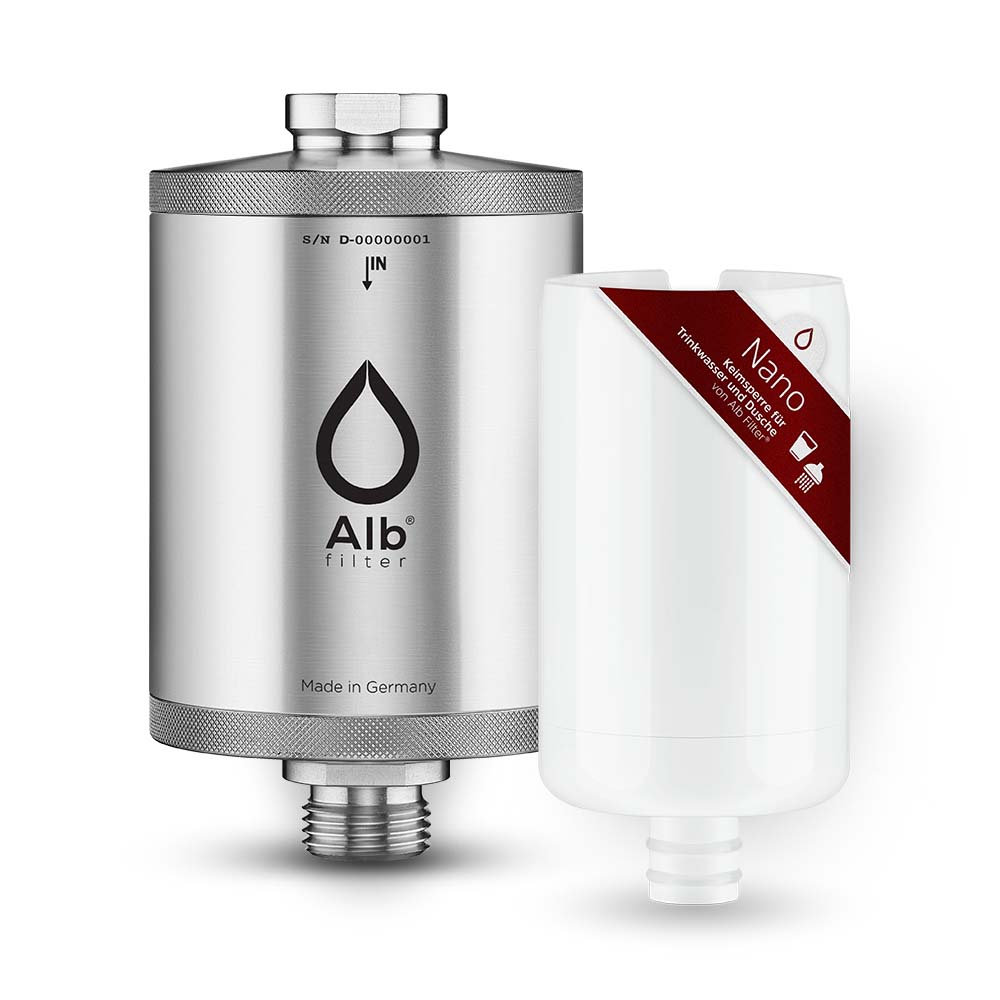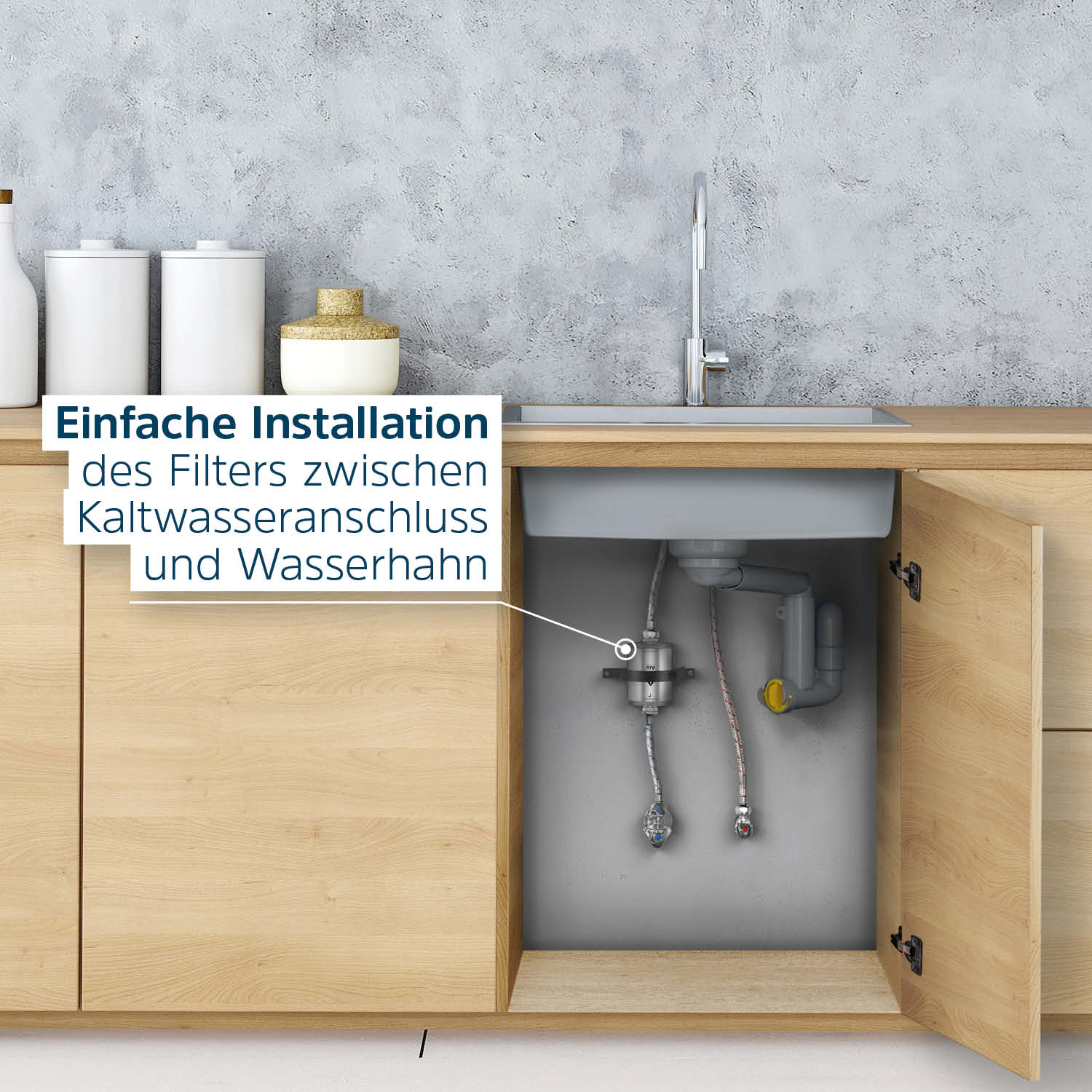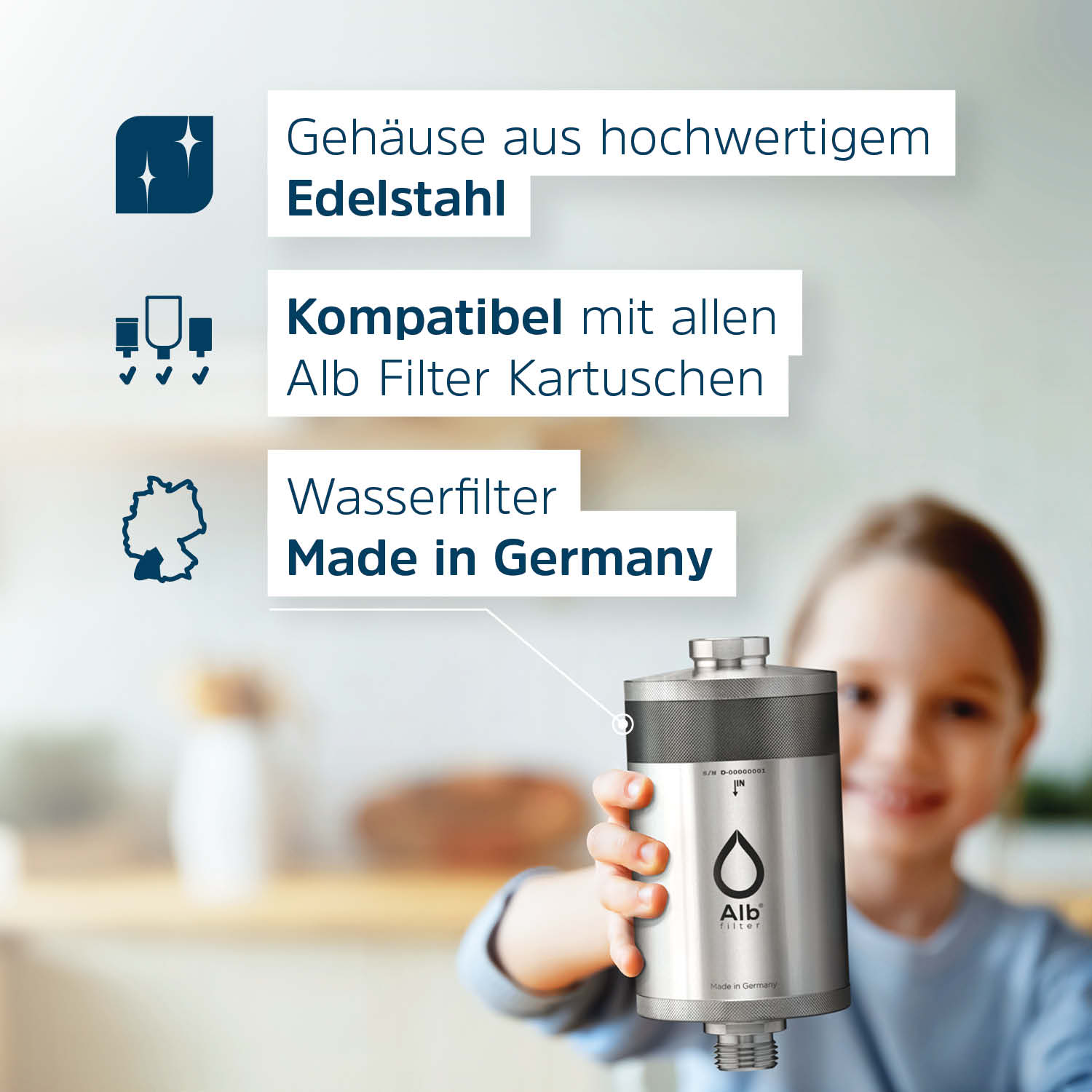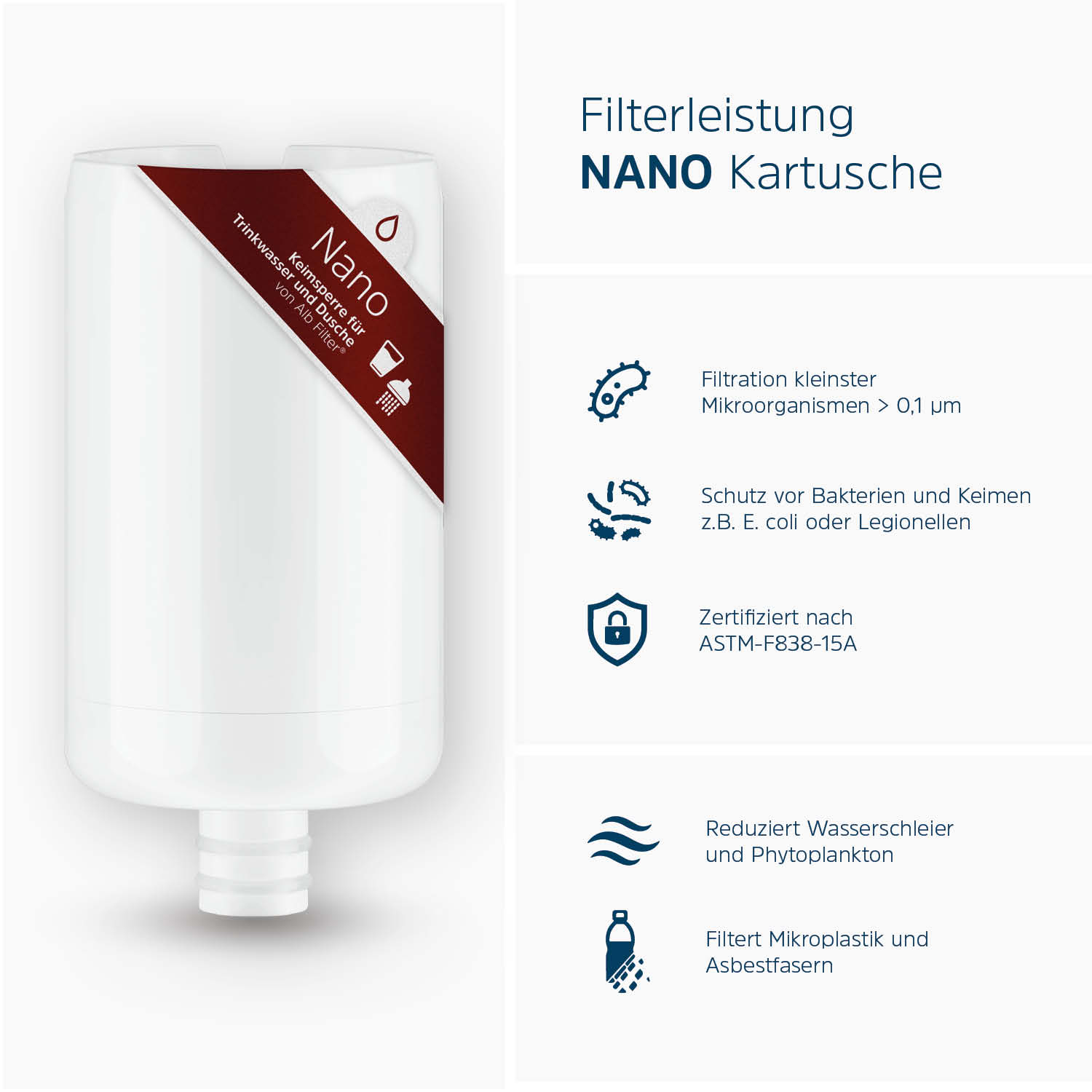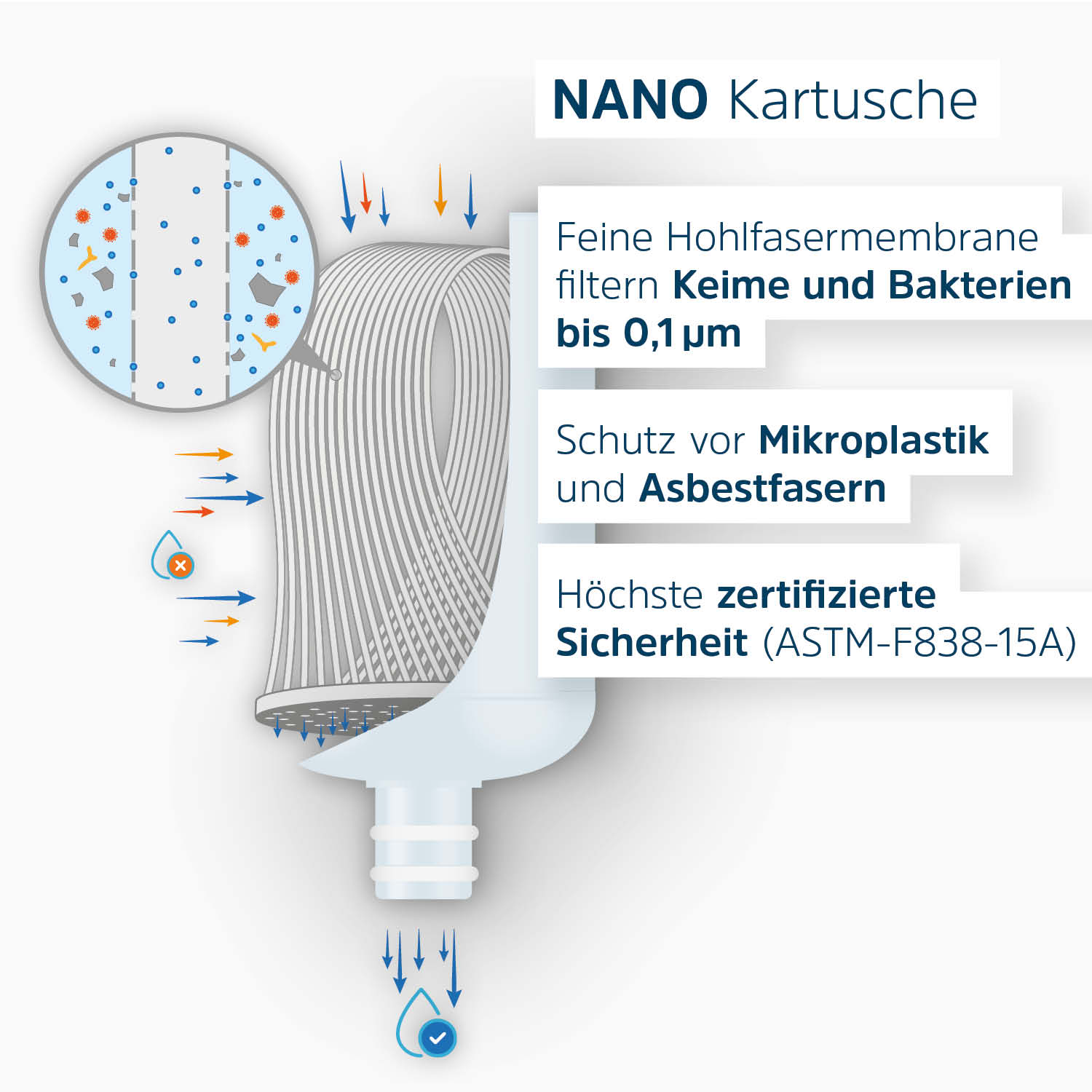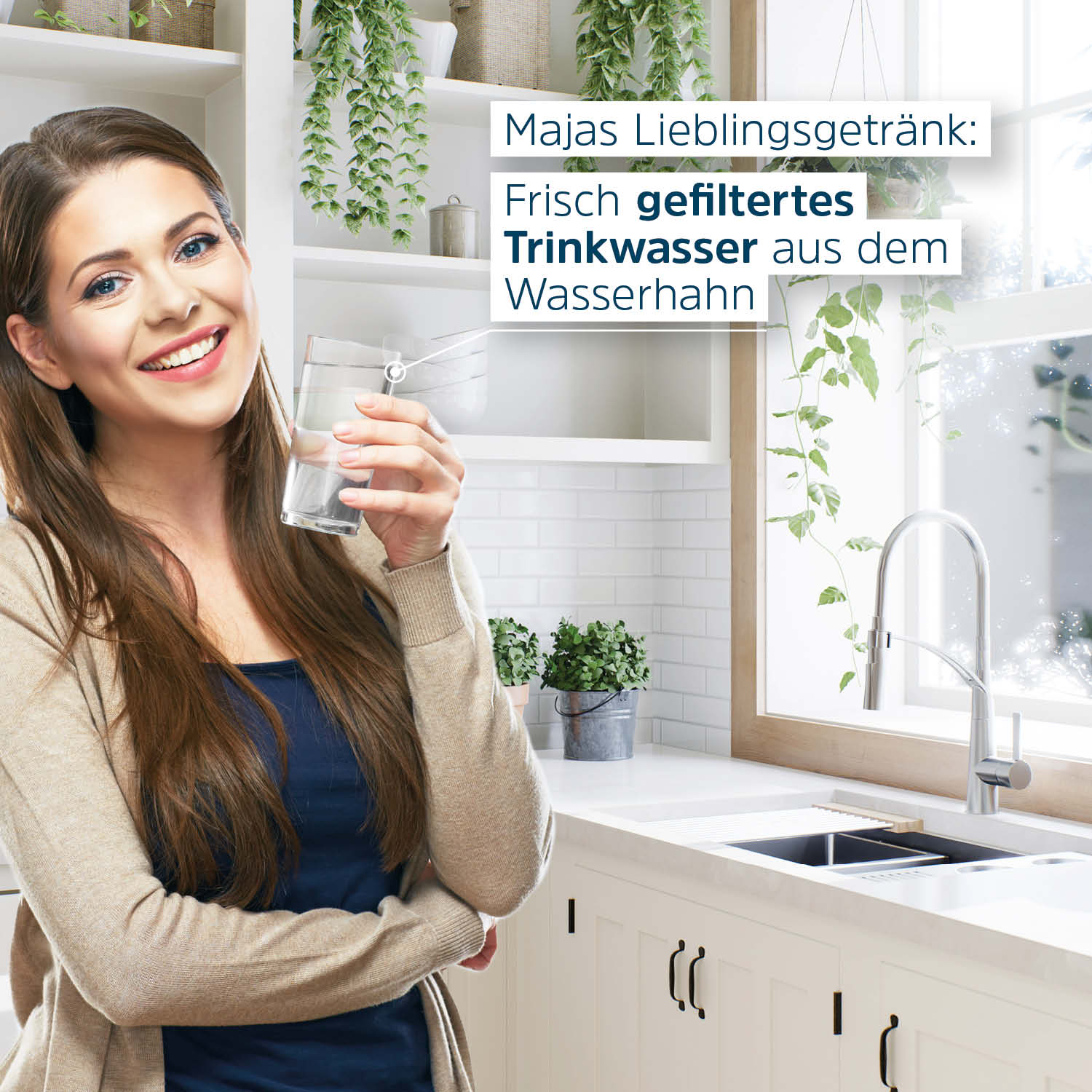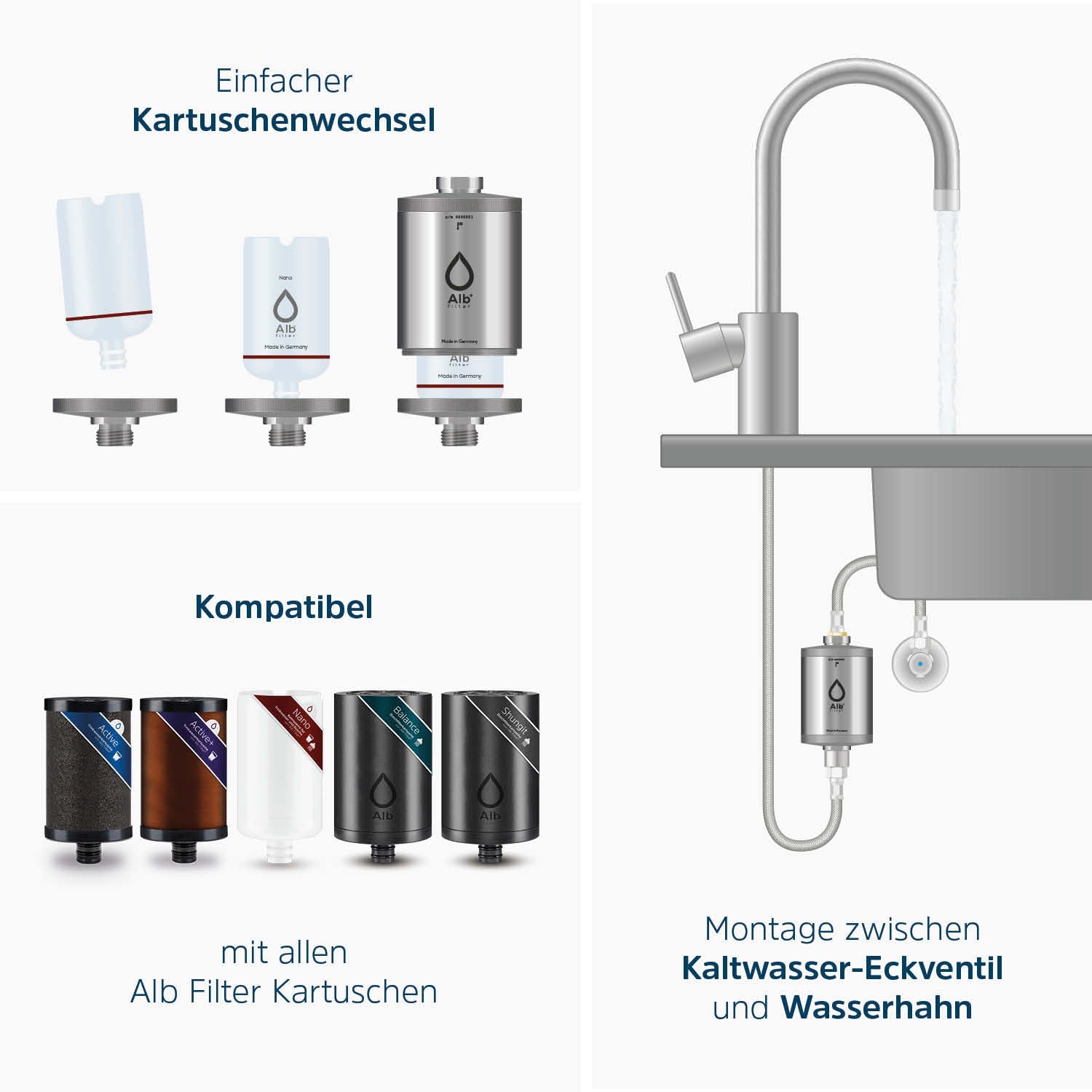Legionella filter: Water filter against legionella
Despite regular checks and legally prescribed preventative measures against legionella formation - e.g. by heating the pipes (thermal disinfection) or chlorinating the water - legionella contamination of tap water occurs time and again in Germany: in rented apartments, public facilities (swimming pools and sports halls), care homes and private households. In serious cases, the responsible authorities impose a shower ban, among other things.
Water filter against legionella
In the event of a positive Legionella test result and an acute shower ban, a good Legionella filter provides effective and reliable protection against Legionella infection - e.g. against Legionnaires' disease (= severe pneumonia).
Where & why are legionella filters used?
In high concentrations, legionella can cause serious illnesses - e.g. legionellosis (Legionnaires' disease) or Pontiac fever. An infection with legionella can be fatal, especially in older people and those with a weakened immune system. The water mist emitted by hot water is dangerous. This is because an infection occurs when tiny water particles, the aerosols, are inhaled when showering or bathing, for example.
Good to know
Anyone who drinks water contaminated with legionella will only contract an infection in rare cases, e.g. if the water accidentally enters the lungs via the windpipe when swallowed1.
Legionella filters are therefore primarily used in:
- Showers (public or private)
- Whirlpools (public or private)
- Swimming pools
- Sports halls
- Nursing homes
- rented apartments, private households, etc.

Does it make sense to use legionella filters?
Legionella in drinking water and Tapwater are particularly dangerous for humans due to...
- Showers,
- Taps,
- Water jets,
- Humidifier,
- and air conditioning systems,...
... because this allows the finest water droplets - the aerosols - to enter the respiratory tract. Despite regular checks and preventive measures against legionella formation(thermal disinfection or chlorination of the water), the use of a legionella filter is a sensible form of protection, particularly in private households and public facilities.
Public & private measures against legionella infestation
| Measures prescribed by the authorities | Thermal disinfection: Flushing water systems and pipes with water heated to at least 60 degrees Chlorination of water: Flushing water systems and pipes with large quantities of chlorine |
|---|---|
| Measures for private consumers and public institutions | Filter legionella: Use water filters against legionella - e.g. shower filter (activated carbon block filter with membrane) Avoid "standstill" in pipes: Regular use of the pipes and intensive flushing of the pipes (with water above 60 degrees) after long periods of standstill, e.g. after a vacation. |
Good to know
Legionella bacteria have ideal breeding conditions in stagnant water between 30 °C and 45 °C. At temperatures above 60°C, the pathogens die and at temperatures below 20°C, the bacteria only multiply very slowly - if at all. In 2015, however, the Helmholtz Centre for Infection Research (HZI) published a study which showed that Legionella can survive temperatures above 60°C for a certain period of time2.
Wherever water "fogs up"
A legionella filter should be used wherever "nebulization of drinking water" occurs, for example in showers or whirlpools. As an additional protective measure, it is also appropriate in places where there are people at increased risk. A legionella infection can be fatal, especially for the elderly and people whose immune system is compromised. Nursing homes in particular should therefore pay special attention to the safety of their drinking water3.

Misty shower due to water vapor. If the shower is hot, aerosols are produced which may pose a risk of legionella.
Wherever the risk of infection is high
Infection usually occurs through inhalation of aerosols of the pathogen Legionella pneumophila - generated by domestic or public water systems, e.g. showers, whirlpools or industrial systems such as evaporative cooling systems. Another, albeit rarer, route of infection is microaspiration of contaminated water that accidentally enters the trachea, e.g. when swallowing water 4 5.
Transmission risk?
Human-to-human transmission does not play a role in practice and - apart from one individual case - has not been documented to date.
Legionellosis is another name for the dangerous Legionnaires' disease. According to the report, this was recorded more than 1500 times in Germany in 2019, which corresponds to a 7% increase in the number of cases. The RKI explains the increase as follows:
Quote
"This could be due to changing climatic conditions, changing demographics (more older people) or greater diagnostic awareness in the hospital sector."
The report also provides information on the places where people infected with legionellosis contracted the bacterium.
- In first place is the professional and private environment (approx. 40%).
- In second place are "travel-associated illnesses". Infections occurred in hotels or other accommodation (approx. 20%).
- Hospitals, care facilities and unknown sources of infection follow in third place (approx. 30%).
The RKI writes about this in the report:
Quote
"According to the available data, Legionnaires' disease is mainly acquired on an outpatient basis in the private and professional environment or as part of a trip and the associated stays in appropriate travel accommodation. However, an inpatient stay in a hospital or nursing home can also pose an increased risk of infection - especially for older people with underlying illnesses or a weakened immune system."
Where the use of legionella filters makes sense
- in private households
- Hotels & Accommodation
- in hospitals
- Swimming pools
- when traveling (at home & abroad)
- when camping
- in nursing homes
- Sports halls
How does a legionella filter work?
There is a wide range of water filters that promise protection against germs, including legionella. In order to make this protection measurable, there are a number of criteria that are also prescribed for Legionella filters in the form of technical standards. The water filtered by them must meet the international standard for sterile filtered water7.
1. quality criteria
It is crucial that the bacteria are not released into the air with the water. To achieve this, the membrane of the water filter for legionella must have a very small pore size, which is smaller than the size of the bacteria. One criterion for the quality of a legionella filter is the 8-log levels, which are used as part of filter validation.
2. log levels
The so-called log levels are a mathematical process. For example, a log reduction of 1 (Log1) reduces around 90 percent of the germs, i.e. 100,000,000 microorganisms are reduced to 10,000,000. At Log6, there is already a reduction of 99.9999 percent, which still corresponds to a number of 100 microorganisms at the initial size of 100,000,000.
At the highest level, Log8, there is only one single microorganism left.
| Log reduction | Reduction in % | Reduction from 100,000,000 microorganisms to |
|---|---|---|
| 1 | 90 | 10.000.000 |
| 2 | 99 | 1.000.000 |
| 3 | 99,9 | 100.000 |
| 4 | 99,99 | 10.000 |
| 5 | 99,999 | 1.000 |
| 6 | 99,9999 | 100 |
| 7 | 99,99999 | 10 |
| 8 | 99,999999 | 1 |
3. technology & maintenance
However, the technical quality of the filter is also particularly important, as it must function permanently under load. The design must be such that leaks are excluded. The consumer must know which maintenance intervals (e.g. regular replacement of cartridges) are necessary and when in order to guarantee the filter's protective function in the long term.
Good to know
Every drinking water filter requires the cartridge to be replaced at certain intervals. We recommend changing the cartridge after a maximum of 4 months - or after 6 months for the Nano shower filter - a water filter against legionella.
How can legionella be filtered?
In practice, various types of filters are used today as Legionella filters. These are mainly ceramic filters, membrane filters and filters whose function is based on reverse osmosis. Legionella filters are also differentiated according to where they are used. There are special filters for the shower, which may already be integrated into the shower head, as well as stand-alone fittings or filters for the tap, which can be used flexibly as water filters in the kitchen or in the shower.
What types of legionella filters are there?
✅ Ceramic filter
Ceramic filters can be used wherever the water pressure is too low for membrane filters - for example when traveling. Ceramic filters have a silver layer that delays the growth of bacteria. The pore size of many models is around 0.2 microns - that is 0.0002 mm. Legionella bacteria have a size of 2-20 µm - that is 0.002-0.02 mm - and can therefore be filtered out efficiently. The Filter capacity of ceramic filters is measurable.
✅ Reverse osmosis filter
In principle, osmosis filters are suitable for filtering legionella from the water, but: osmosis water is not only free from harmful substances such as bacteria and germs, it also contains significantly fewer minerals such as magnesium or calcium than, for example, when filtering with activated carbon.
✅ Membrane filter
Many shower filters against legionella are equipped with membrane technology and this is how it works: The Tapwater is passed through a microporous membrane whose permeability - as with a sieve - depends on the pore size. If the bacteria are larger than the pores, they are retained by the membrane.
✅ Activated carbon block filter with membrane (mobile shower filter)
As activated carbon alone does not provide sufficient protection against legionella, these shower filters with activated carbon are equipped with a high-performance membrane for ultrafiltration down to 0.1 µm - that's 0.001 mm. These water filters therefore provide very effective protection (~99.99%) against germs and pathogens such as legionella, but also against vibrio cholerae, shigella, salmonella and many more in the event of acute germ contamination in the drinking water pipes. This shower filter guarantees the highest level of certified safety.
Tip: The easy-to-install, mobile system offers a high level of protection against unclean water both on vacation and when traveling.
❌ Table jug filter
Classic table jug filters are not suitable for filtering legionella The poured activated carbon used in table jug filters leaves too much space: if the activated carbon is only poured loosely, the filter improves the taste and smell of the water, but fails to filter legionella (and other harmful substances).
❌ Ion exchange filters
Ion exchange filters are designed so that only certain pollutants can be filtered by ion exchange - e.g. by removing lead ions, copper ions or calcium ions. These filter methods are ineffective against bacteria such as legionella.
Only validated legionella filters offer real protection
It is crucial that a legionella filter has the special properties that guarantee safe filtration of the pathogenic legionella bacteria. It is very important to use the right filter cartridges that guarantee at least the Log6 reduction standard. A legionella filter must also be cleaned regularly.

Legionella filters tested in the laboratory. The strict ASTM procedure can only be carried out by certified laboratories.
Good to know
So-called ion exchangers and ordinary table-top can filters do not offer any protection against legionella or other microorganisms.
If you want to ward off legionella, you should make sure that...
- you are unlikely to become infected with Legionella by drinking water,
- most infections occur in professional and private environments and when traveling,
- set the controller temperature on your domestic hot water heater to at least 60 °C
- you can equip your shower heads and other Tapwater systems with membrane filters - e.g. reverse osmosis or activated carbon block filters with membrane - to protect yourself effectively against legionella.
A water filter that is to be used to protect against legionella must be tested and certified, i.e. it must have undergone filter validation.

FAQs
Can legionella be filtered?
It is crucial that a legionella filter has at least the Log6 reduction standard. Log reduction Log1 reduces around 90 percent of the germs, i.e. 100,000,000 microorganisms are reduced to 10,000,000. With Log6, there is already a reduction of 99.99 percent, which still corresponds to a number of 10 microorganisms at the initial size of 100,000,000.
How does a legionella filter work?
A Legionella filter(membrane filter) works according to the principle of ultrafiltration with membrane technology. With a pore size between 0.01 and 0.05 µm, it captures unwanted substances and mechanically filters the bacteria (Legionella pneumophila) out of the water. The bacteria remain in the filter, the water is fed into the supply line and emerges purified.
What does a legionella filter cost?
The Alb Filter Nano costs 135.90 euros. This germ filter can be used to filter drinking water and shower water and, in addition to Legionella, also offers protection against other bacteria, germs and mold in the pipes down to a germ size of 0.1 µm. The filter cartridge costs 59.90 euros and must be replaced every 6 months in continuous operation.
How do you clean a legionella filter?
As a microfilm, which also contains legionella, forms in legionella filters or in the housing after approx. 3-6 weeks, the filters should be cleaned and replaced regularly. The system is cleaned by regularly flushing the entire legionella filter forwards and backwards.
How long does a legionella filter cartridge last?
Every drinking water filter requires the cartridge to be replaced at certain intervals. We recommend changing the cartridge after a maximum of 4 months for our drinking water filters - or after 6 months at the latest for our shower filters.
Related articles and products
Sources
- https://www.rki.de/DE/Content/Infekt/EpidBull/Merkblaetter/Ratgeber_Legionellose.html
- Lesnik, R., Brettar, I. & Höfle, M. Legionella species diversity and dynamics from surface reservoir to tap water: from cold adaptation to thermophily. ISME J 10, 1064-1080 (2016).
- https://www.infektionsschutz.de/erregersteckbriefe/legionellen/
- https://www.lungenaerzte-im-netz.de/
- https://de.wikipedia.org/wiki/Legionella_pneumophila
- https://www.rki.de/DE/Content/Infekt/Jahrbuch/Jahrbuch_2019.pdf?__blob=publicationFile
- https://www.dvgw.de/medien/dvgw/wasser/aufbereitung/anforderungen-an-die-mikrobiologisch-hygienische-trinkwasseruntersuchung-neue-verfahren.pdf


